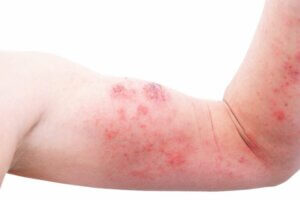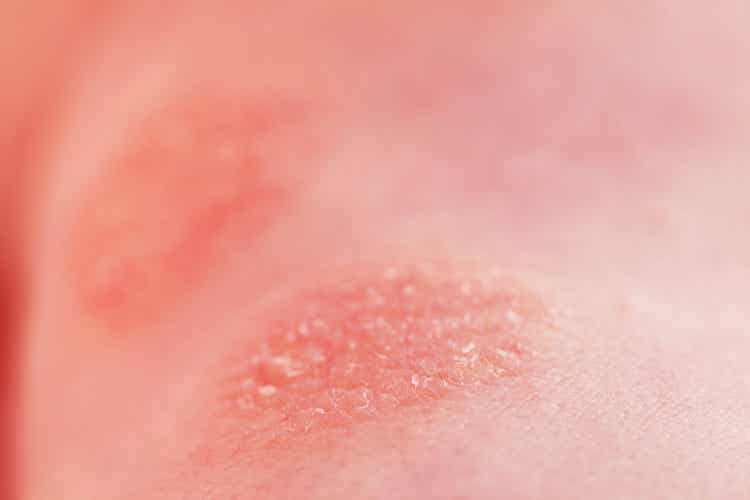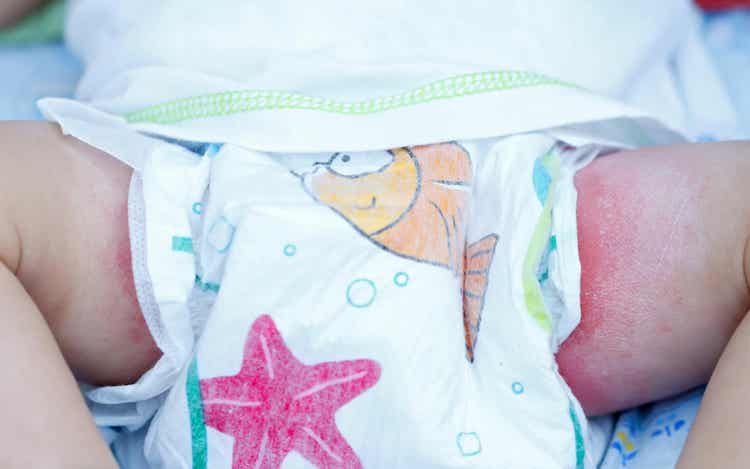10 Types of Dermatitis in Children


Written and verified by the dermatologist Maria del Carmen Hernandez
There are different types of dermatitis in children. When parents notice these rashes, they get anxious and, rightfully, concerned so they take their kid to the doctor. However, the vast majority of these skin conditions are usually benign and aren’t contagious.
Dermatitis occurs when the skin’s surface gets irritated. In addition, it can be accompanied by dry skin, itching, edema, redness, or other characteristic cuts.
Types of dermatitis in children
Children’s skin is more sensitive and delicate than that of adults because they haven’t fully developed yet. Because of that, their skin is more vulnerable to certain external agents and they’re more likely to suffer from certain skin diseases. Here are the most common types of dermatitis in children.
1. Psoriasis
In addition to the skin, psoriasis can sometimes affect nails and joints as well. Children with psoriasis are more prone to diabetes mellitus, obesity, juvenile arthritis, Crohn’s disease, and psychiatric disorders.
Plaques on the skin are erythematous, with overlapping white scales. These commonly develop on the scalp, flexure areas, and the face. Also, the scalp is usually the first place you’ll notice this condition in children. In addition, when it shows up, it will appear symmetrical and the borders will be well-defined.

2. Dermatophytosis
Dermatophyte skin infections and adnexa are common conditions. In addition to what you’ll see on the surface of your skin, it can also negatively affect your quality of life.
The lesions will vary according to the type of dermatophyte that caused them. Also, they’ll vary according to the host’s immune response. In addition, this condition can last for months or years. It could be asymptomatic or it may cause itchiness.
The types are classified according to where it is on your body:
- T. capitis (on the scalp)
- Tinea corporis
- T. pedis (athlete’s foot)
- Tinea unguim.
3. Atopic dermatitis, one of the most common types of dermatitis in children
Atopic dermatitis is the most common inflammatory skin disease. People have a genetic disposition towards it. It occurs when there’s a change in the skin’s barrier and the immune system cannot stay regulated.
This chronic disease has flare-ups and remission. In addition, it’s characterized by reddened skin, edematous, and an intense itchiness. This can lead to scratching, which will cause additional cuts and scars.
When it comes to infants, we see this condition more commonly in areas like the knees and elbows because there’s a lot of flexion. In addition, it’s more common in the wrists and ankles, but it can occur anywhere.
4. Contact dermatitis
Contact dermatitis in children is a common but under-diagnosed condition. Also, there are allergic and irritant variants that we have to rule out. For example, atopic dermatitis, seborrheic dermatitis, psoriasis, and infections have different diagnoses.
The affected area of the skin will be dependent on which body part made direct contact with the physical or chemical agent. In addition, children’s skin has a thinner epidermis compared to that of adults, which makes them more vulnerable to allergic reactions.
Girls often experience contact dermatitis reactions because of perfume found in certain products, like essential oils.
Read also: Protecting the Skin of Children with Cancer
5. Gibert’s pityriasis rosea
This is a benign papulosquamous disorder that heals spontaneously. In most cases, it begins with a single, large, erythematous, scaly plaque, called the heraldic plaque.
After this plaque appears on the neck, you’ll also get a rash with multiple tiny cuts on your back. Interestingly, it will show up in the shape of a Christmas tree.
This type of dermatitis could also be accompanied by the following symptoms:
- Fever
- Arthralgia
- Gastrointestinal disorders
- Sore throat
6. Seborrheic dermatitis, another one of the most common types of dermatitis in children
This is an inflammatory skin condition that occurs in areas of the body with the highest concentration of sebaceous glands. For example, the face, scalp and body folds. Also, the rash is usually painless or itchy.
In most cases, childhood seborrheic dermatitis is mild and heals on its own. In addition, it can even occur in newborns, which is called “cradle cap.”
7. Periorificial dermatitis
This is a benign rash that’s characterized by tiny inflammatory papules and scaly pustules or plaques around the mouth, eyes and nose. A doctor will make the diagnosis after a visual and clinical examination of the cuts. They do this to differentiate this condition with others, like acne vulgaris, rosacia, and sarcidosis.
8. Scabies
Scabies is a contagious skin condition. It’s caused by a mite infection, which is deposited inside the skin and causes intense itching, mostly at night.
Spreading occurs through skin-to-skin contact and transmission of fomites through clothing or sheets. The clinical effects include hyperkeratotic plaques that are found on the soles of the feet, palms, and under the nails. The child, and anyone who has come in close contact with them, will need to be treated.
Keep reading: Scabies in Children: Symptoms, Causes and Treatment
9. Pityriasis versicolor
This is a superficial, benign and common fungal skin infection. Clinical conditions include hyperpigmented or hypopigmented fine scaly macules on the neck and nearby extremities.
Also, it’s caused by a lipophilic fungus, which is a component in the normal skin flora. According to a review published in the Journal of Fungi, topical antifungal drugs are the first-line of treatment for pityriasis versicolor.
10. Diaper rash
This is an inflammatory skin reaction on the surface in the perianal or perineal regions. It’s caused by skin irritation from different external agents, like urine, feces, humidity or other irritants like detergents.

This condition is usually mild and limited to that area of the body. However, on some occasions it can evolve into bacterial superinfections or Candida infections.
What to do about dermatitis in children?
As you can see, each dermatitis has its own options for managing it or treating it. Therefore, when you notice any of these signs or symptoms, we recommend going to a dermatologist.
The specialist will make the diagnosis and will tell you the hygienic measures and treatment to follow in order to heal it. Even though some dermatitis heals on its own, we don’t recommend self-medication or using home remedies.
There are different types of dermatitis in children. When parents notice these rashes, they get anxious and, rightfully, concerned so they take their kid to the doctor. However, the vast majority of these skin conditions are usually benign and aren’t contagious.
Dermatitis occurs when the skin’s surface gets irritated. In addition, it can be accompanied by dry skin, itching, edema, redness, or other characteristic cuts.
Types of dermatitis in children
Children’s skin is more sensitive and delicate than that of adults because they haven’t fully developed yet. Because of that, their skin is more vulnerable to certain external agents and they’re more likely to suffer from certain skin diseases. Here are the most common types of dermatitis in children.
1. Psoriasis
In addition to the skin, psoriasis can sometimes affect nails and joints as well. Children with psoriasis are more prone to diabetes mellitus, obesity, juvenile arthritis, Crohn’s disease, and psychiatric disorders.
Plaques on the skin are erythematous, with overlapping white scales. These commonly develop on the scalp, flexure areas, and the face. Also, the scalp is usually the first place you’ll notice this condition in children. In addition, when it shows up, it will appear symmetrical and the borders will be well-defined.

2. Dermatophytosis
Dermatophyte skin infections and adnexa are common conditions. In addition to what you’ll see on the surface of your skin, it can also negatively affect your quality of life.
The lesions will vary according to the type of dermatophyte that caused them. Also, they’ll vary according to the host’s immune response. In addition, this condition can last for months or years. It could be asymptomatic or it may cause itchiness.
The types are classified according to where it is on your body:
- T. capitis (on the scalp)
- Tinea corporis
- T. pedis (athlete’s foot)
- Tinea unguim.
3. Atopic dermatitis, one of the most common types of dermatitis in children
Atopic dermatitis is the most common inflammatory skin disease. People have a genetic disposition towards it. It occurs when there’s a change in the skin’s barrier and the immune system cannot stay regulated.
This chronic disease has flare-ups and remission. In addition, it’s characterized by reddened skin, edematous, and an intense itchiness. This can lead to scratching, which will cause additional cuts and scars.
When it comes to infants, we see this condition more commonly in areas like the knees and elbows because there’s a lot of flexion. In addition, it’s more common in the wrists and ankles, but it can occur anywhere.
4. Contact dermatitis
Contact dermatitis in children is a common but under-diagnosed condition. Also, there are allergic and irritant variants that we have to rule out. For example, atopic dermatitis, seborrheic dermatitis, psoriasis, and infections have different diagnoses.
The affected area of the skin will be dependent on which body part made direct contact with the physical or chemical agent. In addition, children’s skin has a thinner epidermis compared to that of adults, which makes them more vulnerable to allergic reactions.
Girls often experience contact dermatitis reactions because of perfume found in certain products, like essential oils.
Read also: Protecting the Skin of Children with Cancer
5. Gibert’s pityriasis rosea
This is a benign papulosquamous disorder that heals spontaneously. In most cases, it begins with a single, large, erythematous, scaly plaque, called the heraldic plaque.
After this plaque appears on the neck, you’ll also get a rash with multiple tiny cuts on your back. Interestingly, it will show up in the shape of a Christmas tree.
This type of dermatitis could also be accompanied by the following symptoms:
- Fever
- Arthralgia
- Gastrointestinal disorders
- Sore throat
6. Seborrheic dermatitis, another one of the most common types of dermatitis in children
This is an inflammatory skin condition that occurs in areas of the body with the highest concentration of sebaceous glands. For example, the face, scalp and body folds. Also, the rash is usually painless or itchy.
In most cases, childhood seborrheic dermatitis is mild and heals on its own. In addition, it can even occur in newborns, which is called “cradle cap.”
7. Periorificial dermatitis
This is a benign rash that’s characterized by tiny inflammatory papules and scaly pustules or plaques around the mouth, eyes and nose. A doctor will make the diagnosis after a visual and clinical examination of the cuts. They do this to differentiate this condition with others, like acne vulgaris, rosacia, and sarcidosis.
8. Scabies
Scabies is a contagious skin condition. It’s caused by a mite infection, which is deposited inside the skin and causes intense itching, mostly at night.
Spreading occurs through skin-to-skin contact and transmission of fomites through clothing or sheets. The clinical effects include hyperkeratotic plaques that are found on the soles of the feet, palms, and under the nails. The child, and anyone who has come in close contact with them, will need to be treated.
Keep reading: Scabies in Children: Symptoms, Causes and Treatment
9. Pityriasis versicolor
This is a superficial, benign and common fungal skin infection. Clinical conditions include hyperpigmented or hypopigmented fine scaly macules on the neck and nearby extremities.
Also, it’s caused by a lipophilic fungus, which is a component in the normal skin flora. According to a review published in the Journal of Fungi, topical antifungal drugs are the first-line of treatment for pityriasis versicolor.
10. Diaper rash
This is an inflammatory skin reaction on the surface in the perianal or perineal regions. It’s caused by skin irritation from different external agents, like urine, feces, humidity or other irritants like detergents.

This condition is usually mild and limited to that area of the body. However, on some occasions it can evolve into bacterial superinfections or Candida infections.
What to do about dermatitis in children?
As you can see, each dermatitis has its own options for managing it or treating it. Therefore, when you notice any of these signs or symptoms, we recommend going to a dermatologist.
The specialist will make the diagnosis and will tell you the hygienic measures and treatment to follow in order to heal it. Even though some dermatitis heals on its own, we don’t recommend self-medication or using home remedies.
All cited sources were thoroughly reviewed by our team to ensure their quality, reliability, currency, and validity. The bibliography of this article was considered reliable and of academic or scientific accuracy.
- Kim BE, Leung DYM. Significance of Skin Barrier Dysfunction in Atopic Dermatitis. Allergy Asthma Immunol Res. 2018 May;10(3):207-215. doi: 10.4168/aair.2018.10.3.207. PMID: 29676067; PMCID: PMC5911439.
- Kimball AB, Wu EQ, Guérin A, Yu AP, Tsaneva M, Gupta SR, Bao Y, Mulani PM. Risks of developing psychiatric disorders in pediatric patients with psoriasis. J Am Acad Dermatol. 2012 Oct;67(4):651-7.e1-2. doi: 10.1016/j.jaad.2011.11.948. Epub 2012 Jan 13. PMID: 22243764.
- Heukelbach J, Feldmeier H. Scabies. Lancet. 2006 May 27;367(9524):1767-74. doi: 10.1016/S0140-6736(06)68772-2. PMID: 16731272.
- Gupta AK, Foley KA. Antifungal Treatment for Pityriasis Versicolor. J Fungi (Basel). 2015 Mar 12;1(1):13-29. doi: 10.3390/jof1010013. PMID: 29376896; PMCID: PMC5770013.
- Prasad HR, Srivastava P, Verma KK. Diaper dermatitis–an overview. Indian J Pediatr. 2003 Aug;70(8):635-7. doi: 10.1007/BF02724253. PMID: 14510084.
This text is provided for informational purposes only and does not replace consultation with a professional. If in doubt, consult your specialist.








